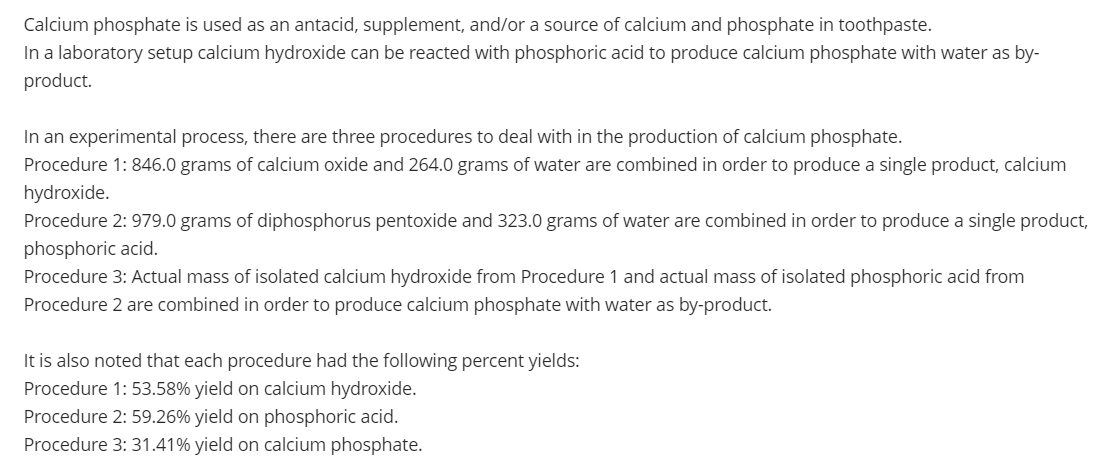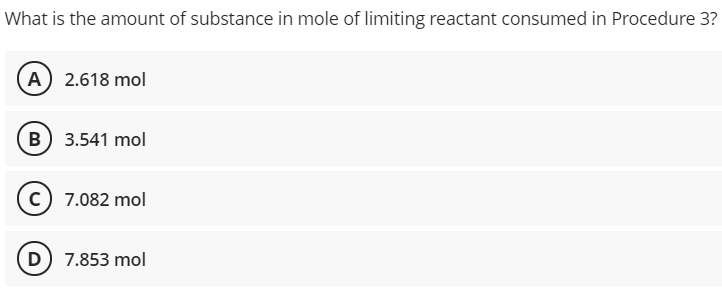Chemistry
10th Edition
ISBN:9781305957404
Author:Steven S. Zumdahl, Susan A. Zumdahl, Donald J. DeCoste
Publisher:Steven S. Zumdahl, Susan A. Zumdahl, Donald J. DeCoste
Chapter1: Chemical Foundations
Section: Chapter Questions
Problem 1RQ: Define and explain the differences between the following terms. a. law and theory b. theory and...
Related questions
Question

Transcribed Image Text:Calcium phosphate is used as an antacid, supplement, and/or a source of calcium and phosphate in toothpaste.
In a laboratory setup calcium hydroxide can be reacted with phosphoric acid to produce calcium phosphate with water as by-
product.
In an experimental process, there are three procedures to deal with in the production of calcium phosphate.
Procedure 1: 846.0 grams of calcium oxide and 264.0 grams of water are combined in order to produce a single product, calcium
hydroxide.
Procedure 2: 979.0 grams of diphosphorus pentoxide and 323.0 grams of water are combined in order to produce a single product,
phosphoric acid.
Procedure 3: Actual mass of isolated calcium hydroxide from Procedure 1 and actual mass of isolated phosphoric acid from
Procedure 2 are combined in order to produce calcium phosphate with water as by-product.
It is also noted that each procedure had the following percent yields:
Procedure 1: 53.58% yield on calcium hydroxide.
Procedure 2: 59.26% yield on phosphoric acid.
Procedure 3: 31.41% yield on calcium phosphate.

Transcribed Image Text:What is the amount of substance in mole of limiting reactant consumed in Procedure 3?
(A) 2.618 mol
B) 3.541 mol
c) 7.082 mol
D 7.853 mol
Expert Solution
This question has been solved!
Explore an expertly crafted, step-by-step solution for a thorough understanding of key concepts.
Step by step
Solved in 2 steps

Knowledge Booster
Learn more about
Need a deep-dive on the concept behind this application? Look no further. Learn more about this topic, chemistry and related others by exploring similar questions and additional content below.Recommended textbooks for you

Chemistry
Chemistry
ISBN:
9781305957404
Author:
Steven S. Zumdahl, Susan A. Zumdahl, Donald J. DeCoste
Publisher:
Cengage Learning

Chemistry
Chemistry
ISBN:
9781259911156
Author:
Raymond Chang Dr., Jason Overby Professor
Publisher:
McGraw-Hill Education

Principles of Instrumental Analysis
Chemistry
ISBN:
9781305577213
Author:
Douglas A. Skoog, F. James Holler, Stanley R. Crouch
Publisher:
Cengage Learning

Chemistry
Chemistry
ISBN:
9781305957404
Author:
Steven S. Zumdahl, Susan A. Zumdahl, Donald J. DeCoste
Publisher:
Cengage Learning

Chemistry
Chemistry
ISBN:
9781259911156
Author:
Raymond Chang Dr., Jason Overby Professor
Publisher:
McGraw-Hill Education

Principles of Instrumental Analysis
Chemistry
ISBN:
9781305577213
Author:
Douglas A. Skoog, F. James Holler, Stanley R. Crouch
Publisher:
Cengage Learning

Organic Chemistry
Chemistry
ISBN:
9780078021558
Author:
Janice Gorzynski Smith Dr.
Publisher:
McGraw-Hill Education

Chemistry: Principles and Reactions
Chemistry
ISBN:
9781305079373
Author:
William L. Masterton, Cecile N. Hurley
Publisher:
Cengage Learning

Elementary Principles of Chemical Processes, Bind…
Chemistry
ISBN:
9781118431221
Author:
Richard M. Felder, Ronald W. Rousseau, Lisa G. Bullard
Publisher:
WILEY